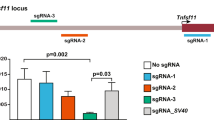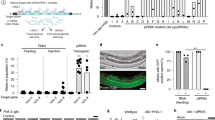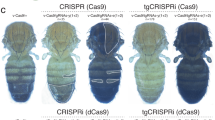Abstract
RNA interference (RNAi) is an extremely effective tool for studying gene function in almost all metazoan and eukaryotic model systems. RNAi in mice, through the expression of short hairpin RNAs (shRNAs), offers something not easily achieved with traditional genetic approaches—inducible and reversible gene silencing. However, technical variability associated with the production of shRNA transgenic strains has so far limited their widespread use. Here we describe a pipeline for the generation of miR30-based shRNA transgenic mice that enables efficient and consistent targeting of doxycycline-regulated, fluorescence-linked shRNAs to the Col1a1 locus. Notably, the protocol details crucial steps in the design and testing of miR30-based shRNAs to maximize the potential for developing effective transgenic strains. In all, this 14-week procedure provides a fast and cost-effective way for any laboratory to investigate gene function in vivo in the mouse.
This is a preview of subscription content, access via your institution
Access options
Subscribe to this journal
Receive 12 print issues and online access
$259.00 per year
only $21.58 per issue
Buy this article
- Purchase on Springer Link
- Instant access to full article PDF
Prices may be subject to local taxes which are calculated during checkout





Similar content being viewed by others
Change history
11 October 2013
In the version of this article initially published, the catalog number given for ESGRO (ESG1106) was incorrect. The correct catalog number should be ESG1107. The error has been corrected in the HTML and PDF versions of the article.
References
Zeng, Y., Wagner, E.J. & Cullen, B.R. Both natural and designed micro RNAs can inhibit the expression of cognate mRNAs when expressed in human cells. Mol. Cell 9, 1327–1333 (2002).
Dickins, R.A. et al. Probing tumor phenotypes using stable and regulated synthetic microRNA precursors. Nat. Genet. 37, 1289–1295 (2005).
Stegmeier, F., Hu, G., Rickles, R.J., Hannon, G.J. & Elledge, S.J. A lentiviral microRNA-based system for single-copy polymerase II-regulated RNA interference in mammalian cells. Proc. Natl. Acad. Sci. USA 102, 13212–13217 (2005).
Premsrirut, P.K. et al. A rapid and scalable system for studying gene function in mice using conditional RNA interference. Cell 145, 145–158 (2011).
Grimm, D. et al. Fatality in mice due to oversaturation of cellular microRNA/short hairpin RNA pathways. Nature 441, 537–541 (2006).
Castanotto, D. et al. Combinatorial delivery of small interfering RNAs reduces RNAi efficacy by selective incorporation into RISC. Nucleic Acids Res. 35, 5154–5164 (2007).
McBride, J.L. et al. Artificial miRNAs mitigate shRNA-mediated toxicity in the brain: implications for the therapeutic development of RNAi. Proc. Natl. Acad. Sci. USA 105, 5868–5873 (2008).
Fellmann, C. et al. Functional identification of optimized RNAi triggers using a massively parallel sensor assay. Mol. Cell. 41, 733–746 (2011).
Beard, C., Hochedlinger, K., Plath, K., Wutz, A. & Jaenisch, R. Efficient method to generate single-copy transgenic mice by site-specific integration in embryonic stem cells. Genesis 44, 23–28 (2006).
Hochedlinger, K., Yamada, Y., Beard, C. & Jaenisch, R. Ectopic expression of Oct-4 blocks progenitor-cell differentiation and causes dysplasia in epithelial tissues. Cell 121, 465–477 (2005).
Yu, J. & McMahon, A.P. Reproducible and inducible knockdown of gene expression in mice. Genesis 44, 252–261 (2006).
Dickins, R.A. et al. Tissue-specific and reversible RNA interference in transgenic mice. Nat. Genet. 39, 914–921 (2007).
Vidigal, J.A. et al. An inducible RNA interference system for the functional dissection of mouse embryogenesis. Nucleic Acids Res. 38, e122 (2010).
McJunkin, K. et al. Reversible suppression of an essential gene in adult mice using transgenic RNA interference. Proc. Natl. Acad. Sci. USA 108, 7113–7118 (2011).
Hemann, M.T. et al. An epi-allelic series of p53 hypomorphs created by stable RNAi produces distinct tumor phenotypes in vivo. Nat. Genet. 33, 396–400 (2003).
Gounari, F. et al. Loss of adenomatous polyposis coli gene function disrupts thymic development. Nat. Immunol. 6, 800–809 (2005).
Kuraguchi, M. et al. Adenomatous polyposis coli (APC) is required for normal development of skin and thymus. PLoS Genet. 2, e146 (2006).
Yang, Y. et al. Methylation analysis of the adenomatous polyposis coli (APC) gene in adult T-cell leukemia/lymphoma. Leukemia Res. 29, 47–51 (2005).
Vert, J.P., Foveau, N., Lajaunie, C. & Vandenbrouck, Y. An accurate and interpretable model for siRNA efficacy prediction. BMC Bioinformatics 7, 520 (2006).
Lagos-Quintana, M., Rauhut, R., Lendeckel, W. & Tuschl, T. Identification of novel genes coding for small expressed RNAs. Science 294, 853–858 (2001).
Zuber, J. et al. Toolkit for evaluating genes required for proliferation and survival using tetracycline-regulated RNAi. Nat. Biotechnol. 29, 79–83 (2010).
Meerbrey, K.L. et al. The pINDUCER lentiviral toolkit for inducible RNA interference in vitro and in vivo. Proc. Natl. Acad. Sci. USA 108, 3665–3670 (2011).
Echeverri, C.J. et al. Minimizing the risk of reporting false positives in large-scale RNAi screens. Nat. Methods 3, 777–779 (2006).
Seidman, C.E., Struhl, K., Sheen, J. & Jessen, T. Introduction of plasmid DNA into cells. Curr. Protoc. Mol. Biol. 1.8.1–1.8.10 (2001).
Kingston, R.E., Chen, C.A. & Rose, J.K. Calcium phosphate transfection. Curr. Protoc. Mol. Biol. 9.1.1–9.1.10 (2003).
Silva, J.M. et al. Second-generation shRNA libraries covering the mouse and human genomes. Nat. Genet. 37, 1281–1288 (2005).
Brown, T. Southern blotting. Curr. Protoc. Mol. Biol. 2.9.1–2.9.20 (2001).
Zhao, X.Y., Lv, Z., Li, W., Zeng, F. & Zhou, Q. Production of mice using iPS cells and tetraploid complementation. Nat. Protoc. 5, 963–971 (2010).
Gertsenstein, M. et al. Efficient generation of germ line transmitting chimeras from C57BL/6N ES cells by aggregation with outbred host embryos. PLoS ONE 5, e11260 (2010).
Tucker, K.L., Wang, Y., Dausman, J. & Jaenisch, R. A transgenic mouse strain expressing four drug-selectable marker genes. Nucleic Acids Res. 25, 3745–3746 (1997).
McCurrach, M.E. & Lowe, S.W. Methods for studying pro- and antiapoptotic genes in nonimmortal cells. Methods Cell. Biol. 66, 197–227 (2001).
Acknowledgements
We thank C. Beard and R. Jaenisch (Whitehead Institute) for pBS31 flp-in and pCAGs-FLPe-Puro vectors, Col1a1 3′ probe and KH2 ES cells. We thank J. Bolden, A. Lujambio and J. White for advice on technical procedures and critical review of the manuscript. Thanks to L. Bianco, J. Coblentz, E. Earl and the Cold Spring Harbor Laboratory animal house staff. We gratefully acknowledge J. Simon, D. Grace and J. Cappellani for technical assistance, and members of the Lowe laboratory for advice and discussions. This study was supported by a Mouse Models of Human Cancer Consortium grant and a program project grant from the National Cancer Institute. P.K.P. was a Medical Science Training Program Fellow of Stony Brook University, L.E.D. is supported by a National Health & Medical Research Council of Australia overseas Biomedical Training Fellowship, C.M. was supported by a fellowship from the Deutsche Forschungsgemeinschaft and an American Association for Cancer Research–Astellas USA Foundation Fellowship in Basic Cancer Research, J.Z. was the Andrew Seligson Memorial Fellow, R.A.D. is a Victorian Endowment for Science, Knowledge and Innovation (VESKI) Fellow and G.J.H. and S.W.L. are Howard Hughes Medical Institute investigators.
Author information
Authors and Affiliations
Contributions
L.E.D. designed and performed experiments, analyzed data and wrote the paper. P.K.P. and J.Z. designed and performed experiments and analyzed data. C.F., K.M., C.M. and Y.P. designed and performed experiments. R.A.D. and G.J.H. designed experiments. S.W.L. designed experiments and wrote the paper.
Corresponding author
Ethics declarations
Competing interests
P.K.P., C.F., G.J.H and S.W.L. are founders of Mirimus Inc., a company that has licensed technology related to this work.
Supplementary information
Supplementary Fig. 1
High copy retroviral transduction leads to overestimation of protein knockdown A. Flow cytometry analysis of NIH3T3 cells infected with pLMP-Ren.713 48hr post transduction (upper) and 5 days post puromycin selection (lower). Prior to and following selection, 'High copy' transduced cells show higher GFP expression than 'single copy' populations, reflecting higher levels of expression of the shRNAmir. B. Western blots for multiple individual shRNAmirs targeting two genes (APC and Bcl2), shows that high copy retroviral transduction leads to an overestimation of the potency of individual shRNAmirs. C. Graphs showing quantitation of APC mRNA transcript by quantitative PCR (top) and protein levels (bottom) measured by densitometry of the western blot shown in B. QPCR analysis indicates a reduction in mRNA levels but does not discriminate well between shRNAmirs that produce varying levels of protein depletion. In each case the values are normalized to a loading control (β2M for QPCR and β-actin for Western blot) and plotted relative to the 3T3 control. (EPS 8806 kb)
Supplementary Table 1
Strategies for developing transgenic mice strains. (PDF 31 kb)
Supplementary Table 2
Tissue specificities for dox-induced GFP-shRNAmir expression. (PDF 68 kb)
Rights and permissions
About this article
Cite this article
Dow, L., Premsrirut, P., Zuber, J. et al. A pipeline for the generation of shRNA transgenic mice. Nat Protoc 7, 374–393 (2012). https://doi.org/10.1038/nprot.2011.446
Published:
Issue Date:
DOI: https://doi.org/10.1038/nprot.2011.446
This article is cited by
-
Generation of precision preclinical cancer models using regulated in vivo base editing
Nature Biotechnology (2024)
-
Mfap4: a promising target for enhanced liver regeneration and chronic liver disease treatment
npj Regenerative Medicine (2023)
-
MicroRNA-101a enhances trabecular bone accrual in male mice
Scientific Reports (2022)
-
A versatile transposon-based technology to generate loss- and gain-of-function phenotypes in the mouse liver
BMC Biology (2022)
-
m6A-independent genome-wide METTL3 and METTL14 redistribution drives the senescence-associated secretory phenotype
Nature Cell Biology (2021)
Comments
By submitting a comment you agree to abide by our Terms and Community Guidelines. If you find something abusive or that does not comply with our terms or guidelines please flag it as inappropriate.



